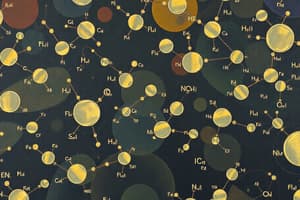Podcast
Questions and Answers
What does a molecular symbol indicate?
What does a molecular symbol indicate?
- The composition and number of atoms in a molecule. (correct)
- The state of matter of a substance.
- The charge of an ion.
- The simplest ratio of atoms in a compound.
Which of the following examples represents a cation?
Which of the following examples represents a cation?
- Cl⁻
- NH₄⁻
- Na⁺ (correct)
- SO₄²⁻
What is the purpose of balancing chemical equations?
What is the purpose of balancing chemical equations?
- To ensure the same number of each type of atom on both sides. (correct)
- To show the physical state of reactants.
- To indicate the charge of ions.
- To represent the molecular formulas of the products.
Which of the following chemical formulas is an empirical formula?
Which of the following chemical formulas is an empirical formula?
What do state symbols in a chemical reaction represent?
What do state symbols in a chemical reaction represent?
Flashcards are hidden until you start studying
Study Notes
Symbols of Chemistry
-
Chemical Symbols:
- Represent elements on the periodic table.
- Composed of one or two letters.
- First letter is always capitalized.
- Second letter, if present, is lowercase.
- Examples:
- Hydrogen (H), Carbon (C), Oxygen (O), Sodium (Na).
-
Molecular Symbols:
- Indicate the composition of molecules.
- Written as a combination of chemical symbols.
- Subscripts are used to denote the number of atoms of an element.
- Example:
- Water (H₂O): 2 Hydrogen atoms, 1 Oxygen atom.
-
Chemical Formulas:
- Convey the types and numbers of atoms in a compound.
- Empirical formula: simplest ratio of atoms (e.g., CH₂ for ethylene).
- Molecular formula: actual number of atoms (e.g., C₂H₄ for ethylene).
-
Ionic Symbols:
- Represent ions with a charge.
- Cations (positive ions) and anions (negative ions).
- Example:
- Sodium ion (Na⁺), Chloride ion (Cl⁻).
-
Common Polyatomic Ions:
- Group of atoms bonded together with an overall charge.
- Examples:
- Sulfate (SO₄²⁻), Nitrate (NO₃⁻), Ammonium (NH₄⁺).
-
Chemical Reactions:
- Represented using reactants and products.
- Reactants on the left, products on the right.
- Example:
- 2H₂ + O₂ → 2H₂O (combustion of hydrogen).
-
Balancing Equations:
- Required for all chemical reactions to obey the law of conservation of mass.
- Adjust coefficients to ensure the same number of each type of atom on both sides.
-
State Symbols:
- Indicate the physical state of a compound in a reaction.
- Common symbols:
- (s) - solid
- (l) - liquid
- (g) - gas
- (aq) - aqueous (dissolved in water).
-
Key Concepts:
- Understanding chemical symbols and formulas is essential for studying chemistry.
- Proper use of symbols facilitates communication of chemical information.
Chemical Symbols
- Represent elements, consisting of one or two letters.
- First letter is capitalized; if a second letter exists, it is lowercase.
- Examples include Hydrogen (H), Carbon (C), and Sodium (Na).
Molecular Symbols
- Indicate the composition of molecules using chemical symbols.
- Subscripts denote the number of atoms of each element within a molecule.
- Example: Water is represented as H₂O, indicating 2 Hydrogen and 1 Oxygen atom.
Chemical Formulas
- Convey the types and quantities of atoms in a compound.
- Empirical formulas show the simplest ratio of atoms (e.g., CH₂ for ethylene).
- Molecular formulas provide the actual number of atoms (e.g., C₂H₄ for ethylene).
Ionic Symbols
- Represent ions, which carry a charge; include cations (positive) and anions (negative).
- Examples include Sodium ion (Na⁺) and Chloride ion (Cl⁻).
Common Polyatomic Ions
- Groups of atoms bonded together that carry an overall charge.
- Notable examples include Sulfate (SO₄²⁻), Nitrate (NO₃⁻), and Ammonium (NH₄⁺).
Chemical Reactions
- Represented with reactants on the left and products on the right.
- Example of a reaction: 2H₂ + O₂ → 2H₂O represents the combustion of hydrogen.
Balancing Equations
- Essential for obeying the law of conservation of mass in chemical reactions.
- Coefficients are adjusted to ensure an equal number of each atom type on both sides.
State Symbols
- Indicate the physical state of a compound during a reaction.
- Common state symbols include:
- (s) for solid
- (l) for liquid
- (g) for gas
- (aq) for aqueous (dissolved in water).
Key Concepts
- Fundamental understanding of chemical symbols and formulas is crucial for studying chemistry.
- Proper use of symbols enhances effective communication of chemical information.
Studying That Suits You
Use AI to generate personalized quizzes and flashcards to suit your learning preferences.




